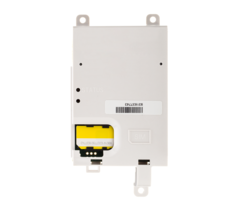How Do I Re-Seat the SIM on My Communicator?
First, find the SIM for your device. It is usually on the back side of the cellular modem. Then, fully power down the panel. Next, remove the cellular device, and extract the SIM. Make sure it is clean, with no fingerprints. Reverse the process re-assembling the device. Finally, power up.
Often, the SIM card in a cellular communicator may need to be re-seated due to the device's inability to connect to its cellular network successfully. This can be indicated by a display of no signal strength, or in some cases, by the communicator resetting over and over again in an attempt to acquire a signal. This can happen due to the device having been jostled during shipping or during the installation process.
Arguably, the most difficult part of re-seating the SIM card is locating it and then gaining access to it. By following the steps outlined below, you will be able to locate the SIM for your device and re-seat it to restore cellular communication to the device.
1. Locate the SIM. Be sure the device is powered completely down before you proceed. You can power down the system by disconnecting its backup battery and then unplugging the transformer. A blank screen will indicate that the system has been fully powered down.
The 3GL, the LTE-L57A, and LTE-L57V are the easiest SIMs to locate. The SIM sits right on top of the module, in plain sight. To reach it, simply open the Lynx Touch in which it's installed.
The Vista-GSM4G is mounted as a daughter board to the Vista-21iP with its SIM facing the Vista-21iP. In order to access the SIM remove the Vista-GSM4G from the main panel and flip it over.
The IGSMV4G, GSMV4G and the GSMX4G each have a cellular modem (outlined in red below) that sits as a daughter board atop the main printed circuit board. To access the SIM, you will first need to remove the two screws at the bottom of the daughter board. Then, carefully disconnect the daughter board from the main board, and flip it over. On the back, you will see the SIM card.


2. Remove the SIM. Usually, with the exception of the 3GL, LTE-L57A, and LTE-L57V the SIM is held in place by a plastic gate. To remove it, you need to slide the gate to the open position and lift up. The SIM card will then slide out. Flip the SIM over, and make sure the gold metal portions of the card are clean. Wipe with a clean, soft cloth if necessary. The SIM for the LynxTouch panels can easily be slid from the cellular device using a thumb or finger. Simply place your thumb or finger on the SIM and slide it toward the nearest edge of the module until it comes free.


3. Re-insert the SIM, and re-install the modem. Make sure the SIM is inserted fully into place. The notch at one end of the SIM will help to ensure it is inserted correctly. Lock the plastic gate covering the SIM into position. If the modem was removed, carefully re-install the cellular modem daughter board to the main printed circuit board. The Vista-GSM4G communicator will attached directly to the Vista-21iP main board. The SIM for the 3GL will simply slide back into place.
4. Power up. Give the device a few minutes to boot, and acquire a signal from the carrier. Then check the signal strength. In some cases, the SIM may need to be re-seated again. Honeywell recommends trying to re-seat the SIM three (3) times. If after the third try there's still no signal, and assuming the location should have a good signal, replace the device. Make sure the SIM is activated and that if it was activated recently that the system has been completely rebooted before replacement.
Did you find this answer useful?
We offer alarm monitoring as low as $10 / month
Click Here to Learn MoreRelated Products




Related Categories
- Answered
- Answered By
- Julia Ross
